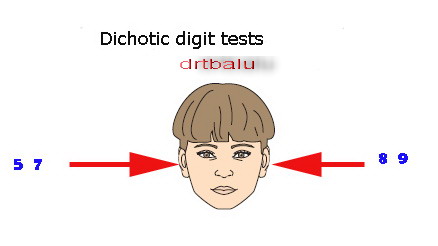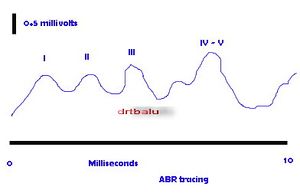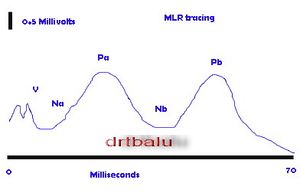Central Auditory Dysfunction
Contents
Introduction:
Severe auditory difficulties are associated with disorders involving the central auditory pathways. The routine tests used to identify peripheral hearing abnormalities have failed to mask these central disorders. It was only during the mid 1950's physicians from Italy started using distorted speech tests to document the presence of auditory difficulties in patients with temporal lobe lesions.
Definition:
The term "central deafness" has been used to refer to the disorder experienced by individuals with bilateral hemispherical involvement of the auditory areas of the brain. The term central auditory deafness has also been used to refer to disorders involving the auditory tracts within the subcortex / brainstem areas.
Synonyms:
Auditory agnosia, Word deafness, verbal auditory agnosia
Cortical deafness:
This term is used to describe patients with significant cortical involvement in the primary auditory areas.
Auditory agnosia:
This term is used to refer to the inability to identify environmental sounds in the presence of normal hearing, and is frequently associated with with amusia (inability to recognise music).
Verbal auditory agnosia:
This term is used to refer to a condition where the patient is unable to decode language information in the presence of normal hearing sensitivity.
Role of central auditory processing:
Katz, Stecker & Henderson(1992) described central auditory processing as “what we do with what we hear.” In otherwords it is the ability of the brain to process incoming auditory signals. The brain identifies sound by analysing their physical characteristics - (frequeny, intensity and temporal features). On completion of this analysis the brain constructs an "image" of the signal which is used to compare with the similar stored images. If a match occurs, we can then understand what is being said or we can recognize sounds that have important meanings in our lives (sirens, doorbells, crying, etc.). This explanation is infact an oversimplification.
Central auditory processes are the auditory system mechanisms and processes responsible for the following behavioral phenomena:
1. Sound localization and lateralization
2. Auditory discrimination
3. Temporal aspects of audition including
4. Temporal resolution
5. Temporal masking
6. Temporal integration
7. Temporal ordering
8. Auditory performance with competing acoustic signals
9. Auditory performance with degraded signals
Central auditory processing disorders: can be defined as a deficiency in any one or more of the behavioral phenomena listed above. In children it is commonly associated with maturational delays involving the central auditory pathways.
Aetiology:
Central auditory dysfunction can be caused by:
1. Trauma
2. Neoplasms
3. Degenerative processes
4. Metabolic dysfunctions
5. Neurotoxicity
6. Viral infections
7. Neuromaturational delays
Common features associated with central auditory processing disorders:
· Difficulty hearing in noisy situations · Difficulty following long conversations · Difficulty hearing conversations on the telephone · Difficulty learning a foreign language or challenging vocabulary words · Difficulty remembering spoken information (i.e., auditory memory deficits) · Difficulty taking notes · Difficulty maintaining focus on an activity if other sounds are present (i.e., child is easily distracted by other sounds in the environment) · Difficulty with organizational skills · Difficulty following multistep directions · Difficulty in directing, sustaining, or dividing attention · Difficulty with reading and/or spelling · Difficulty processing nonverbal information (e.g., lack of music appreciation)
Tests used to identify Central auditory processing disorders:
These tests fall under two main categories:
1. Behavioral tests
2. Electrophysiological tests
Behavioral tests:
The auditory pathway is really rich in its nerves. This facilitates easy understanding of spoken words when even parts of the syllable are missing. This facility can be easily be compromised in patients with central auditory system processing disorders.
Monoaural low redundancy speech tests: The aim of this test is to ascertain the ability of a patient to understand spoken words even when part of it are missing. The speech stimuli used in this test is changed in one or more of the following characteristics:
1. Frequency
2. Temporal characteristics
3. Intensity characteristics
Compressed speech test:
is one of the classic examples of Monoaural low redundancy speech tests. This test is performed using speech signals which have been modified electronically by removing portions of it. The test items are presented to each ear individually and the child is asked to repeat the words that have been presented. A percent correct score is derived for each ear and these are compared to age-appropriate norms.
Masking level difference test:
This involves presentation of a stimulus to both ears at the same time along with a broad band masking noise. The masking noise is presented to both the ears. The patient is tested under two conditions: i.e. Homophasic and Antiphasic conditions. In the homophasic condition the stimulus and the noise are presented in phase to both the ears, where as in antiphasic condition one of the two signals is presented 180 degrees out of phase, while the other signal is maintained in phase between the two ears. In normal individuals the threshold noted in antiphasic condition is better than that obtained in homophasic condition. This is believed to occur due to "release from masking" that is believed to occur at the level of central auditory mechanism. The masking level difference is obtained by subtracting the threshold obtained in one of the antiphase conditions from the threshold obtained in the homophasic condition. Experiments have shown that masking level difference is sensitive to low brain stem lesions.
Dichotic speech tests:
In this test different speech items are presented to both ears either simultaneously or in an overlapping manner, and the child is asked to repeat everything that was heard (divided attention) or repeat whatever is heard from one specified ear (direct attention). The more similar and closely acoustically aligned the test items, the more difficult the task.
Dichotic digit test:
is one of the most commonly used test in this category. The child is asked to listen to four numbers presented to the two ears at comfortable listening levels. In each test item two numbers are presented to one ear and two numbers are presented to the other ear. The child is asked to repeat all numbers heard and a percent correct score is determined for each ear and compared to age-appropriate norms.
Temporal patterning tests:
These tests are designed to test the child’s ability to process nonverbal auditory signals and to recognize the order or pattern of presentation of these stimuli. The child is asked to simply hum the patterns. In this case the processing occurs in the right half of the brain. On the other hand if the child is asked to describe the pattern using words, then the left half of the brain becomes involved, as well as the major auditory fibers that connect the auditory portions of both sides of the brain.
Frequency pattern sequences test:
Is one of the temporal patterning tests used frequently with children. This test involves three tone bursts that are presented to one or both ears. In each of these sequences two tone bursts are of the same frequency, while the third tone is of a different frequency. There are just two different frequencies used in this test. One is a high frequency sound and the other is a low frequency sound. The child therefore hears patterns, such as high-high-low or low-high-low, and is asked to either hum or describe the patterns heard. The test items are presented at levels that are comfortable for the child and the results are adjusted against the age adjusted norms.
Binaural interaction tests:
This is also one of the temporal patterning tests. This test is also known as binaural integration tests. These tests tap the ability of structures low in the brain (brainstem) to take incomplete information presented to the two ears and fuse or integrate this information in some manner. Most of the tests in this category present different parts of a speech signal to each ear separately. If only one part of the signal is presented, the child usually cannot recognize the test item. However, if the two different parts of the stimuli are presented simultaneously, with one portion going to one ear and the other portion to the other ear, the child with normal processing abilities has no difficulty recognizing the test item.
Rapidly alternating speech perception test:
Introduced by Williford in 1976 is one of the more commonly used binaural interaction tests. In this test the sentence materials are divided into various segments and are presented alternatingly to both the ears. If the child hears only the segments presented to the right ear or left ear, he or she is unlikely to be able to recognize the sentence. However, if the right ear and left ear segments are presented in a cohesive fashion to the child, sentence recognition improves dramatically as long as this particular function of the brain is intact.
Electrophysiologica tests:
Among the various tests available only two are commonly employed. They are the auditory brainstem response and mid latency response.
Auditory brain stem response:
This test is very useful in detecting and evaluating auditory brainstem involvement. The auditory brain stem response tracing in individuals with normal hearing demonstrates three dependable positive waves labelled as waves I, III, and the IV - V complex. Waves II, VI and VII also occur, but they are not dependable as a tool of evaluation. It was demonstrated by Moller etal that waves I and II are generated by the distal and proximal portions of the auditory nerve. Wave III is associated with cochelar nucleus and waves IV - V probably arises from activity of superior olivary complex and the nuclei of lateral lemniscus.
Extensions of I-III interval can be seen in auditory nerve and cochlear nucleus involvement. Extensions of III-V are usually noted in pathologies of central auditory nervous system above the level of cochlear nucleus. Absent waves IV and V are seen in patients with involvement of mid and upper pons. If there is brain stem involvement all waves following waves I and II are absent. Interaural latency differences of wave V could be useful to identify acoustic neuromas.
Middle latency response:
Components of middle latency response include: Na, Pa, Nb, and Pb waves. Among these waves the Na - Pa complex is most commonly used in clinical evaluations. The mid latency response is generated from thalamocortical pathways and auditory cortex. The amplitude of these waves are more useful in pathological states than their latency. This is in contrast to auditory brain stem response waves.
Management of central auditory processing disorders in children:
It is common knowledge that children with APD typically do poorly in noisy environments. A major objective in their management is to enhance the signal, and reduction of competing environmental noise. The signal to noise ratio is thus enhanced.
Signal enhancement is possible with the use of assistive devices, preferred seating, and reduction of noise.
Aims in management of these children are:
1. Improve the patients auditory abilities.
2. Enhancement of patient's cognitive / linguistic skills.
3. Improving the listening environment



